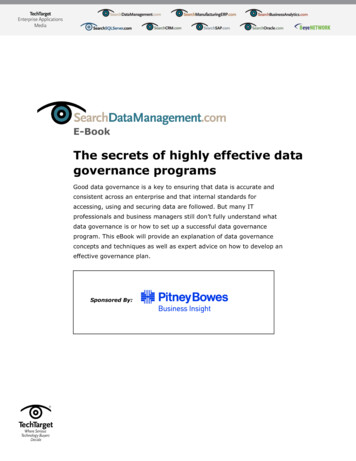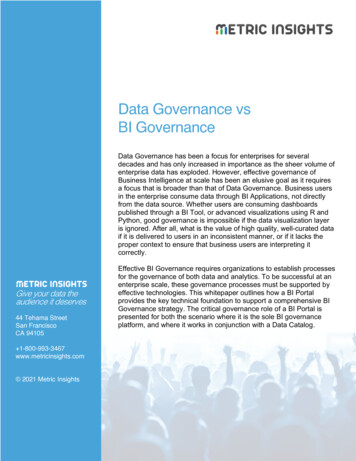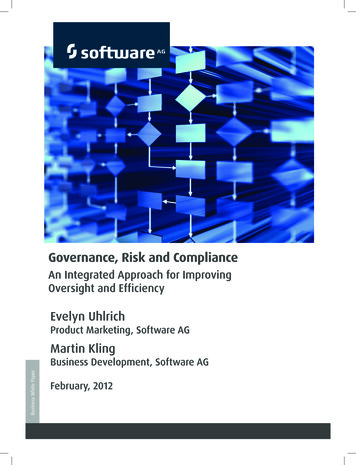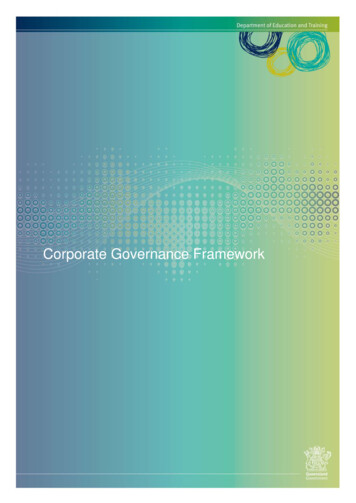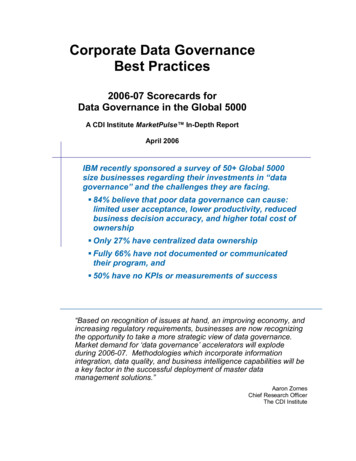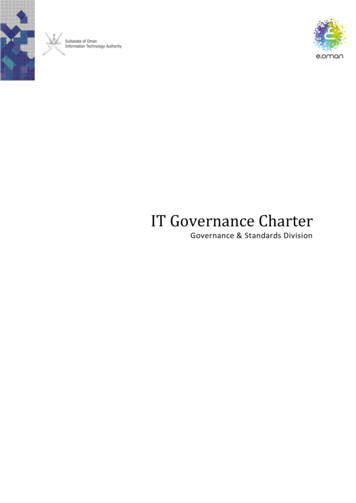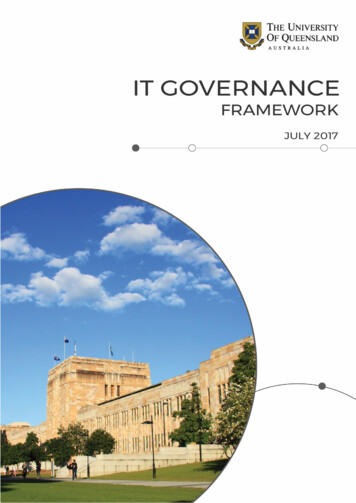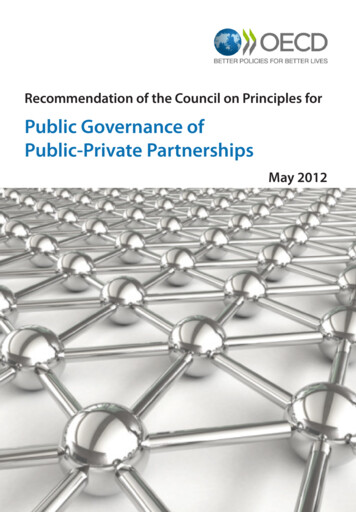
Transcription
Recommendation of the Council on Principles forPublic Governance ofPublic-Private PartnershipsMay 2012
Cover Photo Credit: Thinkstock/ Connection
Recommendation of the Council on Principles forPublic Governance of Public-Private PartnershipsThe Council,Having regard Articles 1, 2 a), 3 and 5 b) of the Convention on the Organisation for EconomicCo-operation and Development of 14 December 1960;Having regard to the Recommendation of the Council for Improving the Quality of GovernmentRegulation [C(95)21/FINAL], the subsequent Guiding Principles for Regulatory Quality andPerformance [C(2005)52 and CORR1] and the Recommendation of the Council on regulatorypolicy and governance [C(2012)37], Policy Framework for Investment [Annex 2 to C(2006)68],Recommendation of the Council regarding the Principles for Private Sector Participation inInfrastructure [C(2007)23/FINAL], Recommendation of the Council on Enhancing Integrity inPublic Procurement [C(2008)105];Noting the focus and progress made by Members and non-Members to improve theframework for public governance of Public-Private Partnerships;Noting that the challenges facing governments today and in the foreseeable future, inensuring that Public-Private Partnerships are met by strong public institutions, are affordable,represent value for money and are transparently treated in the national budget process, havenot been addressed systematically in previous OECD recommendations and principles;Recognising that democracy and the rule of law depend upon and require sound regulatoryframeworks, notably relating to fiscal sustainability;Recognising that Public-Private Partnerships are increasingly becoming a prominent methodfor delivering key public services, can deliver value for money transparently and prudently inso far as the right institutional capacities and processes are in place;Noting that the public governance framework for Public-Private Partnerships should be setand monitored at the highest political level, so that a whole of government approach ensuresaffordability, transparency and value for money;Recognising that the current financial crisis makes transparent and prudent managementof contingent fiscal liabilities, as well as government long-term commitments derived fromPublic-Private Partnership contracts particularly necessary.Recognising that the OECD has played a leading role in the international community topromote fruitful interaction between the public and private sector, prudent budgetarypractices and procedures and sound regulatory practices on a whole of governmentapproach; OECD 2012
On the proposal of the Public Governance Committee:I.Recommends that Members take due account of the Principles for public governance ofPublic-Private Partnerships set out below:A.Establish a clear, predictable and legitimate institutional framework supported bycompetent and well-resourced authorities1.The political leadership should ensure public awareness of the relative costs, benefitsand risks of Public-Private Partnerships and conventional procurement. Popularunderstanding of Public-Private Partnerships requires active consultation andengagement with stakeholders as well as involving end-users in defining the project andsubsequently in monitoring service quality.2.Key institutional roles and responsibilities should be maintained. This requires thatprocuring authorities, Public-Private Partnerships Units, the Central Budget Authority,the Supreme Audit Institution and sector regulators are entrusted with clear mandatesand sufficient resources to ensure a prudent procurement process and clear lines ofaccountability.3.Ensure that all significant regulation affecting the operation of Public-Private Partnershipsis clear, transparent and enforced. Red tape should be minimised and new and existingregulations should be carefully evaluated.B.Ground the selection of Public-Private Partnerships in Value for Money4.All investment projects should be prioritised at senior political level. As there are manycompeting investment priorities, it is the responsibility of government to define andpursue strategic goals. The decision to invest should be based on a whole of governmentperspective and be separate from how to procure and finance the project. There shouldbe no institutional, procedural or accounting bias either in favour of or against PublicPrivate Partnerships.5.Carefully investigate which investment method is likely to yield most value formoney. Key risk factors and characteristics of specific projects should be evaluatedby conducting a procurement option pre-test. A procurement option pre-test shouldenable the government to decide on whether it is prudent to investigate a Public-PrivatePartnerships option further.6.Transfer the risks to those that manage them best. Risk should be defined, identified andmeasured and carried by the party for whom it costs the least to prevent the risk fromrealising or for whom realised risk costs the least.7.The procuring authorities should be prepared for the operational phase of the PublicPrivate Partnerships. Securing value for money requires vigilance and effort of the sameintensity as that necessary during the pre-operational phase. Particular care should betaken when switching to the operational phase of the Public-Private Partnerships, as theactors on the public side are liable to change. OECD 2012
8.Value for money should be maintained when renegotiating. Only if conditions changedue to discretionary public policy actions should the government consider compensatingthe private sector. Any re-negotiation should be made transparently and subject tothe ordinary procedures of Public-Private Partnership approval. Clear, predictable andtransparent rules for dispute resolution should be in place9.Government should ensure there is sufficient competition in the market by a competitivetender process and by possibly structuring the Public-Private Partnerships program sothat there is an ongoing functional market. Where market operators are few, governmentsshould ensure a level playing field in the tendering process so that non-incumbentoperators can enter the market.C. Use the budgetary process transparently to minimise fiscal risks and ensure theintegrity of the procurement process10. In line with the government’s fiscal policy, the Central Budget Authority should ensurethat the project is affordable and the overall investment envelope is sustainable.11. The project should be treated transparently in the budget process. The budgetdocumentation should disclose all costs and contingent liabilities. Special care shouldbe taken to ensure that budget transparency of Public-Private Partnerships covers thewhole public sector.12. Government should guard against waste and corruption by ensuring the integrity ofthe procurement process. The necessary procurement skills and powers should bemade available to the relevant authorities.II.Recommends that Members take appropriate steps to ensure that Public-PrivatePartnerships are affordable, represent value for money and are transparentlytreated in the budget process, in accordance with the principles expressed in thisRecommendation, which are recalled and further developed in the Annex to thisRecommendation of which it forms an integral part.III. Invites Members and the Secretary-General to disseminate this Recommendation.IV. Invites non-Members to take account of and adhere to this Recommendation.V.Instructs the Public Governance Committee to monitor the implementation of thisRecommendation and to report thereon to the Council no later than three yearsfollowing its adoption and regularly thereafter, in consultation with other relevantOECD Committees, including the Investment Committee. OECD 2012
OECD Principles for thePublic Governance ofPublic-Private Partnerships OECD 2012
A.Establish a clear, predictable and legitimate institutional framework supported bycompetent and well-resourced authorities1.The political leadership should ensure public awareness of the relative costs, benefitsand risks of Public-Private Partnerships and conventional procurement. Popularunderstanding of Public-Private Partnerships requires active consultation andengagement with stakeholders as well as involving end-users in defining the projectand subsequently in monitoring service quality.Only if the political level is aware of and accepts the costs and benefits of using PPPscan the issues around PPPs be tackled and balanced appropriately with stability andpredictability. The Ministry of Finance, line Ministries and executive agencies shouldensure that a coherent approach to PPP is rolled out in the public sector and is joinedup with other initiatives in adjacent fields. Given their complexity and long-termscope engagement with civil society is a prerequisite for the successful use of PPPs.This is especially the case when PPPs provide key public services. PPPs should, ideally,form part of an integrated public-sector infrastructure investment and procurementframework.Active consultation and engagement with stakeholders should be an integral elementof the process. PPPs may be used to introduce a more private-sector approach toservice delivery in sectors that have previously been a part of the government.This can have effect on both working conditions, the culture of the work placeand opportunities for advancement. Labour unions consequently represent a keystakeholder group that can be substantially affected by the usage of PPPs. For PPPs towork and to be legitimate, labour should be actively involved. The same can be saidfor NGOs and other civil society groups which often have concerns that PPPs may havesocial and environmental consequences and impact the rights of minority groups.Active involvement of NGOs can create transparency about problematic issues thatmight otherwise be overlooked and become serious problems if not tackled at an earlystage.Defining outputs in the PPP contract is essential. It should involve end-users in definingthe project and its output specification and subsequently in monitoring service qualityonce the project is operational. Defining outputs can be instrumental in achievingbetter alignment of service specification with user expectations and exert pressure onservice providers to meet service standards. In addition, involving end-users in designand monitoring increases the likelihood of the effort being perceived as legitimate,fair and understandable. Independent public oversight of PPP implementation canalso promote public sector innovation and better outcomes for the society as a wholethrough greater accountability and social control. OECD 2012
2.Key institutional roles and responsibilities should be maintained. This requires thatprocuring authorities, Public-Private Partnerships Units, the Central Budget Authority,the Supreme Audit Institution and sector regulators are entrusted with clear mandatesand sufficient resources to ensure a prudent procurement process and clear lines ofaccountability.A number of institutional roles should be competently pursued to secure and maintainvalue for money: a sound procurement process; implementing the specific PPP; fiscaland budgeting issues; auditing of the PPP; rule monitoring and enforcement. Theseroles can be maintained in a number of institutional set-ups, but it is important thatthey are kept separate so as not to confuse the key tasks of each actor and to securelines of accountability.The authority that is procuring the PPP is the institution ultimately responsible for theproject, subject to approval, monitoring and advice from the other actors at variousstages. The authority is responsible for preparation, negotiation and administrationof the contract and for monitoring and evaluating contract performance during theconstruction and operation phases of the project. This is crucial to ensure governmentretains value for money during the whole life of the contract. This authority is, therefore, ultimately responsible for the PPP contract and its operation. By value for moneyis meant the optimal combination of quality, features and price, calculated over thewhole of the project’s life.Given the complexity of PPPs and their somewhat infrequent use, critical skills toensure value for money may need to be concentrated in a PPP Unit that is made available to the relevant authorities. A PPP Unit’s function can be pursued by a numberof complementary units. The PPP Unit can fill gaps in terms of specific skills, a lack ofcoordination or high transaction costs. Institutional shortcomings should be addressedtaking the country’s needs and current institutional context into account. The PPP Unitshould enable authorities (e.g. line ministries) to create, manage and evaluate a PPPefficiently and effectively.This role requires that the PPP Unit has the requisite in-depth financial, legal, economicand project management skills. This capacity should be used to assess the specific PPPcompared to the traditional public investment route. The PPP Unit should support theauthority in its endeavor to secure value for money both in the procurement and in theimplementation phases. This Unit should also make sure that procedural steps (gateways) are followed throughout. It is important that the role of the PPP Unit is clear andwithout conflicts of interest. While responsible authorities should draw on expertisefrom the PPP unit where necessary, it should be emphasised that they remain ultimately responsible for the project. Importantly, although the PPP Unit should help therelevant authorities prepare and negotiate the PPP contract, it should not decide onwhether the PPP should move forward. This green-lighting process should be anchoredin the Central Budget Authority. OECD 2012
To secure affordability and project quality the Central Budget Authority should scrutinise each PPP. The Central Budget Authority should check and monitor the PPPthrough each key phase: Planning; Feasibility, Design and Tender Preparation; Biddingand Contract Signing; and Construction and Operation. The Central Budget Authorityshould scrutinise the project for value for money, affordability, procedural steps andthat the projects remain in line with political agreements. While the Central BudgetAuthority need not possess deep and specific knowledge of the PPP project’s technicaldesign, it needs sufficient capacity to evaluate the documentation presented to it. TheCentral Budget Authority should assure that capital investments are aligned with thegovernment’s short and medium term macroeconomic stability targets.The Supreme Audit Institution (SAI) has an important role in examining whether therisks involved in PPPs are managed effectively. The SAI’s reports to Parliament can keepthe public informed about the services that they receive and also disseminate bestpractice. The SAI should audit and assess the PPP ex post with regards to performance,finance and compliance. It should maintain sufficient capacity to give a clear verdict onwhether or not the project ultimately represented value for money, suggest possibleimprovements to the regulatory PPP framework, the procurement processes and makeavailable overall lessons regarding the use of PPPs and investments. All relevant information should be made available to the SAI.Sound regulatory policy promotes the efficient functioning of regulatory agencies byensuring that they operate under an appropriate and clear mandate, with the necessary independence from political influence and regulated subjects, that they are appropriately resourced and equipped, and that their decision-making is fully transparentand accountable. Where PPPs are employed in the delivery of infrastructure facilitieswith natural monopoly characteristics, the role, design and organisation of regulatorsis important to secure value for money for the public sector and protect users andconsumers. This role should be clear to all (staff, regulated entities and the community).The appropriate sector regulator should consequently be consulted in the projectdesign and subsequently monitor compliance with regulated service standards. Thisrole is important not only in shaping the markets, but also with concrete issues suchas service quality, profitability, tariffs and prices. Of particular interest in monopoly-likesituations is the degree of profitability compared to the sector average using variousbenchmarks.The above roles should be institutionally maintained at sub-national level. OECD 2012
3.Ensure that all significant regulation affecting the operation of Public-PrivatePartnerships is clear, transparent and enforced. Red tape should be minimised and newand existing regulations should be carefully evaluated.A regulatory environment which meets the key principles of good regulation, as setout in the OECD Recommendation on Regulatory Policy and Governance, reduces thecosts to business and enhances the chances that PPP projects bring value for money.While the contract is the main basis for a PPP, it is necessary to have a clear andtransparent regulatory framework that all parties can trust, is enforced and thatdoes not create barriers to entry. Such a framework fosters competition and helpsminimising the risk of conflicts of interest, regulatory capture, corruption, andunethical behaviour. To that end, governments should adhere to principles of opengovernment. Access to information and the decision-making process should be openand equitable.Private investment will be facilitated if unnecessary red tape is removed and delaysto approval processes are reduced. An effective regulatory framework implies carefulevaluation of new regulations and systematic review of the stock of significantregulations to ensure that they are up to date, cost effective and consistent anddeliver the intended policy objectives. This may require the coordination of approvalprocesses in specific circumstances to remove regulatory obstacles to the delivery ofPPPs, such as coordinating and streamlining multiple layers of regulation that mayaffect projects – either across one or different levels of government (central/federal,sub-national/state and local). The rule of law and the protection of property rights andcontractual rights are a key condition as also highlighted in the Principles for PrivateSector Participation in Infrastructure.B.Ground the selection of Public-Private Partnerships in Value for Money4.All investment projects should be prioritised at senior political level. As there aremany competing investment priorities, it is the responsibility of government to defineand pursue strategic goals. The decision to invest should be based on a whole ofgovernment perspective and be separate from how to procure and finance the project.There should be no institutional, procedural or accounting bias either in favour of oragainst Public-Private Partnerships.It is important that the projects that go ahead have been prioritised at the politicallevel. The basis for the decision should include an initial cost assessment andevaluation of the opportunity cost that should feed into the affordability decision.The decision to invest should include a holistic cost-benefit analysis addressing theproject’s interaction with other government policy tools (such as spatial planning,regulation of traffic, utilities, and development plans) and objectives. Line ministriesand other actors should not be allowed to develop their investment programs withoutaligning them with the government’s overall political priorities. OECD 2012
On the basis of the initial cost assessment, the holistic cost benefit analysis and thepolitical judgment, an initial affordability decision can be made and projects can beprioritised against each other. The cost-benefit evaluations and the ranking of differentprojects should be made available to the public to encourage debate about whatlarge infrastructure projects are the most important. The investment decision shouldbe separate from the decision as to how to procure and finance the specific project.To strengthen prioritisation between PPPs and traditional infrastructure procurementwithin the budget envelope decisions should be based on a whole of life, presentvalue, approach for both.There should be no institutional, procedural or accounting bias either in favour of oragainst PPPs. Value for money should be the only test as to whether a particular projectis procured by way of a PPP or through conventional procurement routes.5.Carefully investigate which investment method is likely to yield most value formoney. Key risk factors and characteristics of specific projects should be evaluatedby conducting a procurement option pre-test. A procurement option pre-test shouldenable the government to decide on whether it is prudent to investigate a PublicPrivate Partnerships option further.Once the government has decided to move forward with the investment, a projectshould be subjected to a procurement option pre-test. This should guide governmentin selecting which mode of procurement is likely to deliver the most value for money.The following elements should be included in such an examination and therebyindicate to the policy maker whether it is worthwhile to investigate the PPPprocurement option. What are the comparative costs of (a) finance (b) construction (c) operation, ascalculated over the whole lifetime of the project, in each alternative mode ofprocurement? Can the risks of the project be clearly defined, identified and measured? Can the right types of risk be transferred to the private partner to ensure value formoney? Does the project involve any transfer of risks onto other stakeholders, includingworkers and local communities? Is the risk appetite of potential private-sector partners sufficiently robust toexplore a PPP? Do potential private-sector partners have a track record of good service delivery,responsible business conduct and PPP experience? What is the potential level of competition in the market? If competition is lacking,is the market contestable? Is there sufficient market interest in the project to generate a robust competitionthat will ensure a value for money outcome? OECD 2012
How large are the whole of life benefits from combining the construction and theoperating phases of a project in one contract? What are the risks of project failure associated with similar PPPs? What are thecosts to the public authority associated with such failures? What contingent liabilities are associated with the project? Can the risks, cost and quality trade-offs be quantified and managed by the publicsector? Can the desired project output be specified clearly ex ante? Is the plannedproject operating in a rapidly changing policy or demand environment? Are theunderlying assets to be used to deliver the output in an area subject to rapidtechnological change? Is the potential PPP project of a size sufficiently large to justify the transactioncosts? Who will make the contractual payments to the private-sector partner? Can someor all of the payments come from end-user charges? If end-user charges are levied will demand be sufficient over the lifetime of theproject to ensure that the private partner generates the revenue required for it tomaximise its profit? Might the potential private-sector partners accept demandrisk in addition to availability risk?If relevant, further analysis regarding using a PPP should be based on input from aprudent public sector comparator, or an equivalent to compare value for money acrossoptions, especially when operation is an important component of the project. Thereare different methods used to assess the relative value for money of the differentdelivery models. In principle, a public sector comparator compares the net presentcost of bids for the PPP project against the most efficient form of delivery according tothe output specification by conventional public sector means (the so-called referenceproject). The public sector comparator serves as a hypothetical risk-adjusted costof public delivery of the output specification of a PPP project. The methodology forpreparing the public sector comparator should be published.6.Transfer the risks to those that manage them best. Risk should be defined, identifiedand measured and carried by the party for whom it costs the least to prevent the riskfrom realising or for whom realised risk costs the least.After the fundamental assessment of specific issues and comparative costs, the keyelement in the decision to use PPPs is the transfer of risk from the government to theprivate partner. Risk is defined, identified and measured, and either retained by thepublic sector or transferred to the private partner through specific contract terms andan appropriate payment mechanism. Risk should be allocated where it can be bestmanaged. By ‘best’ managed is meant the party for whom it costs the least to preventthe risk from realising, or for whom it costs the least to deal with the consequence ofrealised risk. OECD 2012
Risk should not be transferred to the private partner at any price for the sake oftransferring risk alone or to achieve a desirable accounting treatment. Governmentsand public authorities cannot transfer to the private sector the risks associated withstatutory responsibilities to maintain services.An essential question is whether the risks of the project can be defined, identified andmeasured. The less this is the case, the more room there is for conflict over the contract,particularly when the risk realises. Potential private partners might also be unwilling,for an acceptable price, to take on risks that are not clearly defined, identified andmeasured. There should be clear methods in the contract by which risks can beapportioned when they materialise. This is particularly important in cases where risk isdifficult to measure.7.The procuring authorities should be prepared for the operational phase of thePublic-Private Partnerships. Securing value for money requires vigilance and effortof the same intensity as that necessary during the pre-operational phase. Particularcare should be taken when switching to the operational phase of the Public-PrivatePartnerships, as the actors on the public side are liable to change.There is a danger that after the financial close of the PPP the attention from publicsector decision-makers and key actors is substantially reduced. Should such areduction of attention result in a concomitant reduction of capacity on the public sidevalue for money can be threatened. Monitoring the performance of the PPP in theconstruction phase and the operational phase requires skill and dedication, especiallyas targets may shift and unforeseen, but legitimate, obstacles may arise. It is also theresponsibility of the procuring agency to ensure that the private partner acts accordingto the norms of responsible business conduct as mentioned in the OECD Guidelines forMultinational Enterprises.For the operational phase to be successful all relevant actors should remain involved.The responsibility for the operational phase of the project primarily rests with theprocuring line ministry/ agency. Potential problems should be identified at this leveland dealt with to the extent of these institutions’ mandate. However, the PPP Unit,Central Budget Authority, Supreme Audit Institution and Regulatory Authorities shouldplay their part and retain the appropriate level of ownership regarding the project.Particular attention should be paid to contractual arrangements and monitoringcapacity at later stages of a project so as to ensure that incentives do not deteriorate asthe cost of non-compliance falls. OECD 2012
8.Value for money should be maintained when renegotiating. Only if conditionschange due to discretionary public policy actions should the government considercompensating the private sector. Any re-negotiation should be made transparentlyand subject to the ordinary procedures of Public-Private Partnership approval. Clear,predictable and transparent rules for dispute resolution should be in place.By monitoring and liaising with the private contractor, the public sector shouldmaintain a project’s value for money throughout its operation. The original risk transferand contract terms should be maintained and care should be taken to make sure thatthe standards to which the private-sector contractor operates are not eroded withoutcompensation to the public-sector authority. Clear rules stipulating the criteria,procedures and compensation for government expropriating the asset should be inplace as prescribed in the Guidelines for Multinational Enterprises.Nonetheless, in some cases the assumptions underlying the project may turn out tobe flawed and in extreme cases this can lead the project towards failure. As the publicsector has an interest, sometimes a statutory responsibility, in making sure the assetkeeps operating smoothly; a re-negotiation should take place to investigate possiblesolutions. However, even if the current project outcome differs from what the privatepartner expected, it may just be a realisation of the risk that it carried.Both parties should distinguish between the realisation of risk and a genuineunforeseen change in circumstances. Only if conditions change due to discretionarypublic policy actions (i.e., “actions of the Principal”) should the government considercompensating the private sector. Any other compensation for changes in commercialconditions should be explicitly negotiated within the contract. Otherwise, the risksto re-negotiations of PPP contracts due to changes in international conditions notforeseen at the moment of the contract award could significantly increase fiscal costsof PPPs for the government.Clear, predictable and transparent rules for dispute resolution should be in place toresolve disagreement on the above between the public and private parties.Furthermore, any re-negotiation that substant
framework for public governance of Public-Private Partnerships; Noting that the challenges facing governments today and in the foreseeable future, in ensuring that Public-Private Partnerships are met by strong public institutions, are affordable, represent value for money and are transparently treated in the national budget process, have


